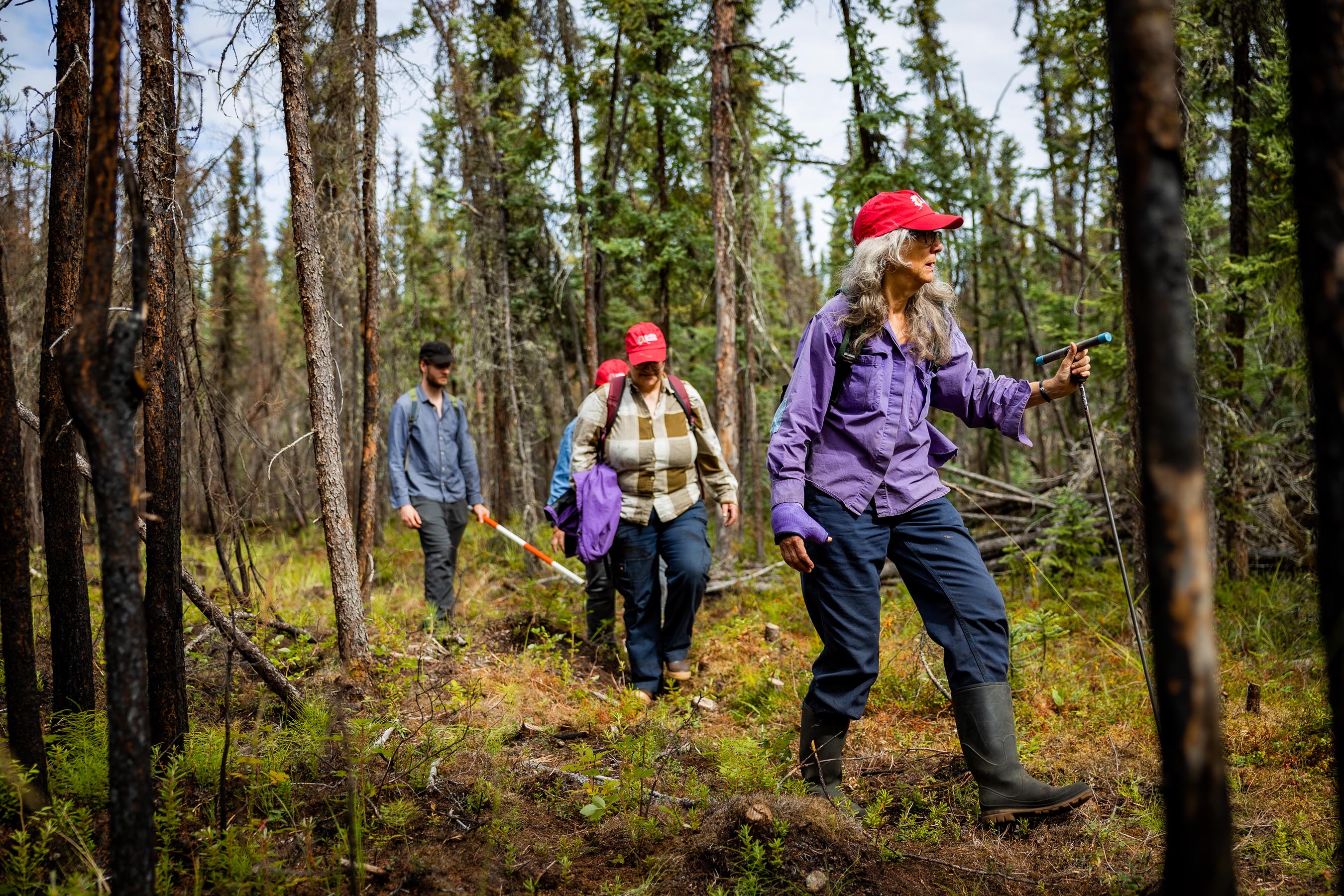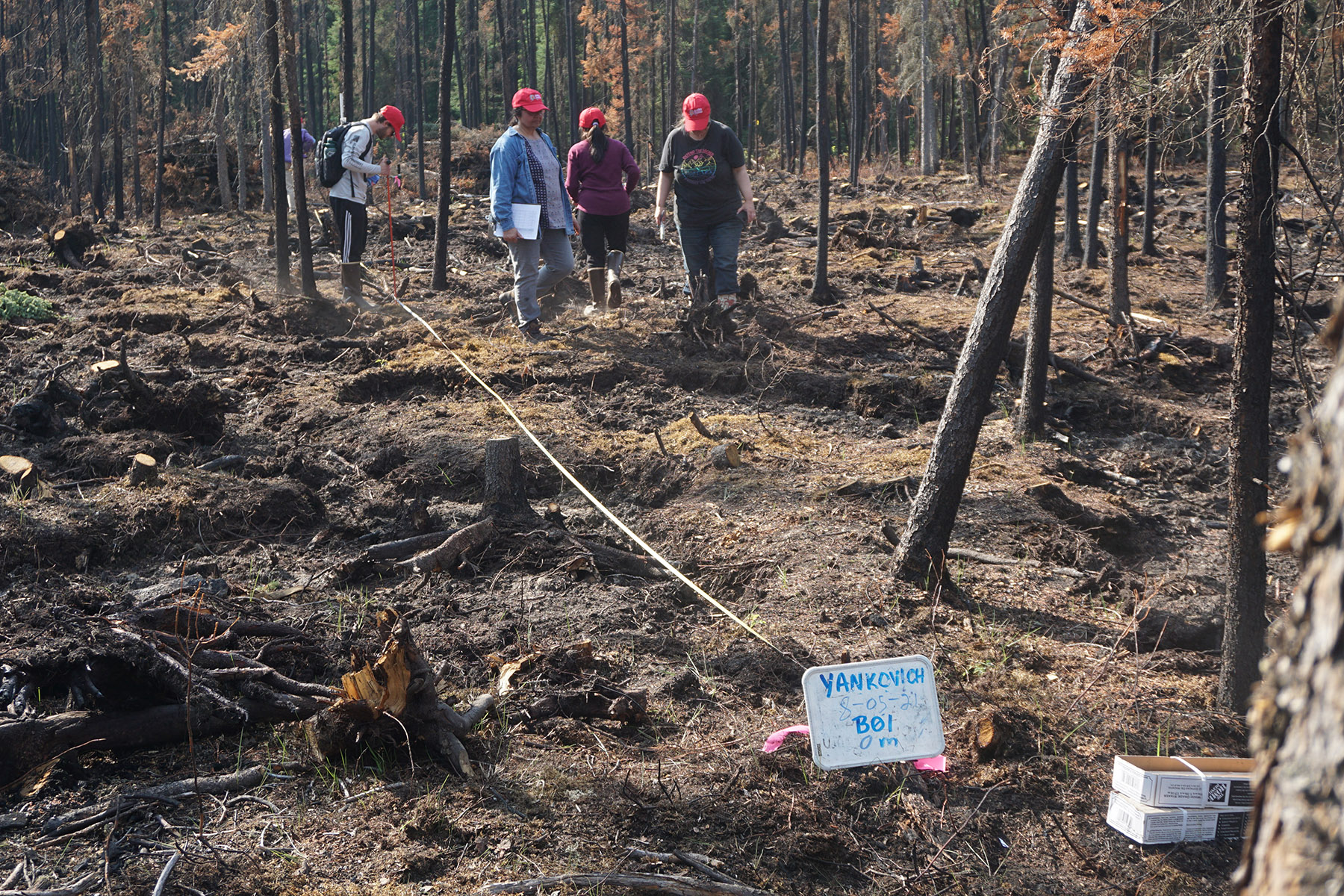A small fire with a big legacy

Researchers led by Alison York hike through the Yankovich Road Fire site in August 2022.
Tom Moran
907-474-5581
Oct. 14, 2022
The Yankovich Road Fire burned less than four acres, but the blaze looms large in the eyes of Alaska fire researchers. They’ve taken advantage of the fire’s convenient location on the University of Alaska Fairbanks North Campus to install monitoring transects for research and training purposes, and now plan to erect a set of interpretive signs to raise public awareness of wildfires.
“It’s mostly just that it’s so easily accessible,” said Alison York, coordinator for the UAF Alaska Fire Science Consortium. “People know where it is, you can park there, you don’t need a permit… It just hit all of us at the same time: This could be a really nice self-guided tour opportunity.”
The Yankovich Road Fire began on the afternoon of July 16, 2021 on the northern edge of the Fairbanks campus, only a short distance away from dozens of houses. Investigators concluded that a lightning strike had ignited the blaze a few days earlier, and it then smoldered until it was detected. Fire agencies responded quickly with helicopter and airplane water drops, ground crews, and even smokejumpers. They swiftly contained the fire to 3.6 acres, stopping it about 330 feet from the closest home.
Behind remained a representative example of a burn in the wildland-urban interface — the area where houses intermix with burnable forests. The site is a 10-minute walk from a public parking lot at the UAF Large Animal Research Station. Eric Miller, a fire ecologist with the U.S. Bureau of Land Management’s Alaska Fire Service, quickly saw the educational possibilities.

Researchers visit the Yankovich Road Fire site in August 2021.
Under Miller’s direction, researchers with BLM, the fire science consortium and the Alaska National Science Foundation Established Program to Stimulate Competitive Research descended on the area later in 2021 to install permanently marked transects to track post-fire changes. They set up 30-meter transects both inside the burn and nearby to serve as controls. They sampled the transects in both 2021 and 2022 to track changes, including living and dead trees, ground-level vegetation, permafrost depth, thickness of the organic soil or duff, material below the forest floor and duff, burn severity, and age of the burned trees.
Fire researchers plan to sample the transects annually to track changes. Chief among their interests are the speed and amount of colonization by invasive species such as vetch, white sweet clover and dandelion, as well as what form the forest will take as it regenerates.
“I think what people are interested in is whether the site is going to come back to black spruce, which it was before the fire, or whether it’s going to transform to a deciduous birch-aspen kind of forest,” Miller noted. “It’s still kind of early to say.”
Miller said the main goal of the transects is to serve as a field classroom. EPSCoR faculty and students have taken part in their installation and monitoring, learning how to follow protocols for monitoring fire effects in Alaska. Miller has also used the site to teach out-of-state fire crews about the boreal fire regime. Most significantly, the site also quickly became a destination for fire scientists to bring visiting researchers on guided field trips, which in turn have grown into a larger project to make the fire site easily accessible to the public.

Researchers Chris Waigl, left, and Eric Miller measure tree heights with a laser altimeter at the Yankovich Road Fire site in August 2021.
The project team plans to install interpretive signs on a route leading from the LARS parking lot to the fire site. Topics will include the importance of wildland fire to the ecosystem, wildland fire management, ecological succession, the impacts of climate change to the boreal forest and the importance of taking steps to protect homes from wildfire.
“The agencies that we work with said, ‘We would really like to have some help in public education, especially around climate change and the wildland-urban interface,’” York said. “To show that Alaska residents need to be prepared that on any random July afternoon, a fire could be erupting in the woods behind your backyard.”
The team will work on graphics and specific messages for the signs over the winter, with the goal of installation in summer 2023. Up to a dozen signs are planned, and a short wood-chip trail will be installed through part of the burn site to improve access. The signs will include QR codes so visitors can find more details online, including updated information on changes to the site over time.
“There is interesting stuff at the site,” Miller noted. “Every time we go out there, we notice something new.”
Financial support for the signs comes from the AFSC, Alaska NSF EPSCoR, the U.S. Department of Agriculture’s National Institute of Food and Agriculture Hatch project 1018914, and the State of Alaska. For more information, visit the AFSC web page about the project or contact Alison York at ayork@alaska.edu.
062-23


